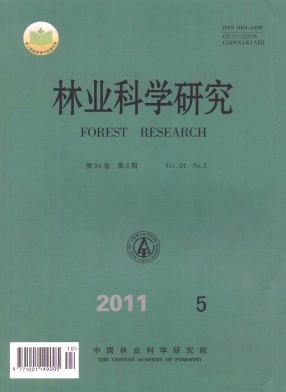|
[1]
|
宋永昌. 植被生态学[M].上海:华东师范大学出版社,2001
|
|
[2]
|
张金屯,孟东平. 芦芽山华北落叶松林不同龄级立木的点格局分析[J].生态学报,2004,24(1): 35-40
|
|
[3]
|
张金屯. 群落二维格局分析的两种方法[J]. 西北植物学报,2004, 24(8): 1448-1451
|
|
[4]
|
张会儒,汤孟平,舒清态.森林生态采伐的理论与实践[M].北京:中国林业出版社, 2006
|
|
[5]
|
叶 芳,彭世揆.种群空间分布理论的发展历史及其现状[J].林业资源管理, 1997(6): 55-58
|
|
[6]
|
惠刚盈,李 丽,赵中华,等.林木空间分布格局研究方法[J].生态学报,2007,27(11):4717-4728
|
|
[7]
|
谢宗强,陈伟烈,刘正宇.银杉种群的空间分布格局[J].植物学报, 1999, 41(1): 95-101
|
|
[8]
|
王太鑫,丁雨龙,刘永建.巴西木竹无性系种群的分布格局[J].南京林业大学学报:自然科学版,2005,29(3): 37-40
|
|
[9]
|
张金屯. 植物种群空间分布的点格局分析[J].植物生态学报,1998, 22(4): 344-349
|
|
[10]
|
Ripley B D. Spatial Statistics[M]. NewYork: Wiley,1981 |
|
[11]
|
Ripley B D.The second-order analysis of stationary point processes[J].Journal of Applied Probability, 1976,13:255-266 |
|
[12]
|
Ripley B D. Modelling spatial pattern[J]. Journal of the Royal Statistical Society. Series B, 1977,39: 172-212 |
|
[13]
|
汤孟平,唐守正,雷相东.Ripley’sK(d)函数分析种群空间分布格局的边缘校正[J].生态学报, 2003,23(8): 1533-1538
|
|
[14]
|
惠刚盈.角尺度——一个描述林木个体分布格局的结构参数[J].林业科学,1999,35(1): 37-42
|
|
[15]
|
徐 海,惠刚盈,胡艳波,等.天然红松阔叶林不同径阶林木的空间分布特征分析[J].林业科学研究, 2006,19(6): 687-691
|
|
[16]
|
王 蕾,张春雨,赵秀海.长白山阔叶红松林的空间分布格局[J].林业科学,2009,45(5):55-60
|
|
[17]
|
侯向阳,韩进轩.长白山红松林主要树种空间格局的模拟分析[J].植物生态学报,1997, 21(3): 242-249
|
|
[18]
|
Wiegand T, Moloney K A. Rings, circles and null models for point pattern analysis in ecology[J].Oikos, 2004,104: 209-229 |
|
[19]
|
徐化成.中国红松阔叶林[M].北京:中国林业出版社,2001
|
|
[20]
|
阳含熙.长白山北坡红松阔叶林主要树种的分布格局[M].森林生态系统研究, 1985(1): 1-14
|
|
[21]
|
张 健,郝占庆,宋 波,等. 长白山阔叶红松林中红松与紫椴的空间分布格局及其关联性[J]. 应用生态学报,2007,18(8):1681-1687
|
|
[22]
|
覃 林.统计生态学[M],北京:中国林业出版社,2009
|
|
[23]
|
汤孟平,周国模,施拥军,等.天目山常绿阔叶林优势种群及其空间分布格局[J]. 植物生态学报,2006,30(5):743-752
|
|
[24]
|
Condit R,Ashton P S,Baker P, et al. Spatial patterns in the distribution of tropical tree species[J].Science, 2000,288:1414-1418 |
|
[25]
|
Schurr F M,Bossdorf O,Milton S J, et al.Spatial pattern formation in semi-arid shrub land: a priori predicted versus observed pattern characteristics[J]. Plant Ecology, 2004,173:271-282 |
|
[26]
|
喻 泓,杨晓晖,慈龙骏.地表火对红花尔基沙地樟子松种群空间分布格局的影响[J]. 植物生态学报,2009,33(1):71-80
|
|
[27]
|
缪 宁,史作民,冯秋红,等. 川西亚高山岷江冷杉种群的空间格局分析[J].林业科学,2008,44(12):1-5
|
|
[28]
|
Yu H, Wiegand T, Yang X, et al. The impact of fire and density-dependent mortality on the spatial patterns of a pine forest in the Hulun Buir sandland, Inner Mongolia, China[J]. Forest Ecology and Management, 2009, 257(10): 2098-2107 |
|
[29]
|
臧润国.红松阔叶林林冠空隙动态的研究 .北京:北京林业大学,1995
|
|
[30]
|
臧润国,郭忠凌,高文韬.长白山自然保护区阔叶红松林林隙更新的研究[J].应用生态学报,1998,9(4):349-353
|
|
[31]
|
宋新章,张慧玲,肖文发,等. 长白山区阔叶红松林采伐林隙种子库研究[J].北京林业大学学报,2009,32(2):17-24
|
|
[32]
|
Nathan R. Long-distance dispersal of plants[J].Science, 2006, 313: 786-788 |
|
[33]
|
He F, Legendre P, La Frankie J V. Distribution patterns of tree species in a Malaysian tropical rain forest[J].Journal of Vegetation Science, 1997,8: 105-11 |





 DownLoad:
DownLoad: